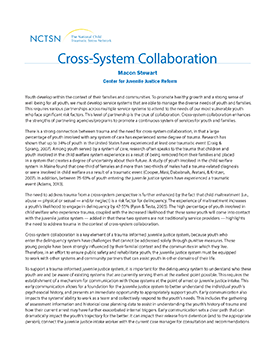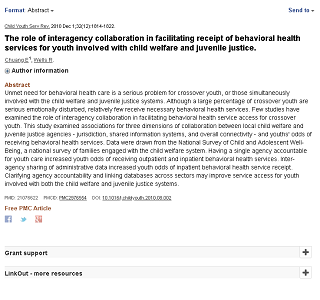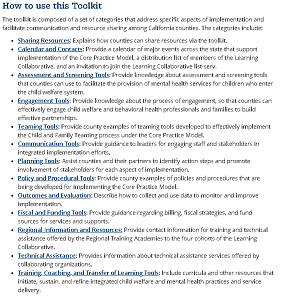-
Cross Systems Collaboration
Cross-System Collaboration
National Child Traumatic Stress Network (NCTSN)GeneralOutlines practice examples for continuity of care and collaboration across systems. Written by Macon Stewart from the Center for Juvenile Justice Reform- 2013
-
The role of interagency collaboration in facilitating receipt of behavioral health services for youth involved with child welfare and juvenile justice
Cross-System Collaboration
Child and Youth Services Review JournalGeneralE. Chuang & R. Wells (2010) Child Youth Serv Rev. 2010 December 1; 32(12): 1814–1822. doi:10.1016/j.childyouth.2010.08.002.
-
A systematic review of the effectiveness of interagency and cross-system collaborations in the United States to improve child welfare outcomes
Cross-System Collaboration
Children and Youth Services ReviewChild WelfareThis systematic review summarizes the effects of interagency and cross system collaboration to improve child welfare outcomes
-
Child Welfare/Mental Health Learning Collaborative Toolkit
Cross-System Collaboration
California Social Work Education Center (CALSWEC)Child Welfare, Behavioral HealthThe Child Welfare/Mental Health Learning Collaborative Toolkit provides resources designed to assist county administrators and staff to implement integrated child welfare and mental health services for families and children participating in both systems.
-
Child Welfare/Mental Health Learning Collaborative Toolkit
Cross-System Collaboration
California Social Work Education Center (CALSWEC)Child Welfare, Behavioral HealthThe Child Welfare/Mental Health Learning Collaborative Toolkit provides resources designed to assist county administrators and staff to implement integrated child welfare and mental health services for families and children participating in both systems.
-
Trauma-Informed Workgroup Meeting Guidelines
Cross-System Collaboration
Trauma Informed OregonGeneralThis set of guidelines, provide structure for creating a trauma informed care workgroup and is applicable to development of a cross-system workgroup.
-
Child Welfare/Mental Health Learning Collaborative Toolkit
Cross-System Collaboration
California Social Work Education Center (CALSWEC)Child Welfare, Behavioral HealthThe Child Welfare/Mental Health Learning Collaborative Toolkit provides resources designed to assist county administrators and staff to implement integrated child welfare and mental health services for families and children participating in both systems.
-
Trauma-Informed Workgroup Meeting Guidelines
Cross-System Collaboration
Trauma Informed OregonGeneralThis set of guidelines, provide structure for creating a trauma informed care workgroup and is applicable to development of a cross-system workgroup.
-
Child and Family Teaming
Cross-System Collaboration
California Social Work Education Center (CALSWEC)Child Welfare, Behavioral HealthAudience: This curriculum is designed as a conjoint training for child welfare and behavioral health practitioners, and partners from child- and family-serving agencies. It is comprised of two 3.5-hour modules that each include role plays for skill practice.
-
Child and Family Teaming
Cross-System Collaboration
California Social Work Education Center (CALSWEC)Child Welfare, Behavioral HealthAudience: This curriculum is designed as a conjoint training for child welfare and behavioral health practitioners, and partners from child- and family-serving agencies. It is comprised of two 3.5-hour modules that each include role plays for skill practice.





